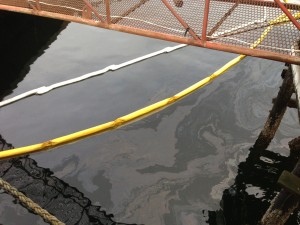A tug boat that sank off the coast of Wrangell late Tuesday afternoon is leaking diesel fuel. KSTK’s Shady Grove Oliver has more on the containment and response effort.
Click here for iFriendly audio.
The 60-foot towing vessel Silver Bay II sank in approximately 120 feet of water about five miles south of the city of Wrangell late Tuesday afternoon.
The vessel had been moored at the former Silver Bay Logging facility for the last five years.
There was no one on board the vessel when it sank and there have been no reported injuries.
The cause of the sinking is still unknown.
Scott Wakefield is a marine science technician, first class, with the US Coast Guard. He says it’s possible the storm that hit southeast that day may have been a factor.
“Well, we think it was weather-related. We know the weather was bad on Tuesday,” says Wakefield.
Sarah Moore is the state on-scene coordinator for spill response in Southeast at the Alaska Department of Environmental Conservation, or ADEC.
She says the vessel has been leaking diesel fuel.
“We are now estimating that the size of the potential spill—so the amount of fuel that is onboard the tug boat—is 3500 gallons of diesel. At this point, we don’t know how much has actually been released,” says Moore.
According to the ADEC situation report released today, a Coast Guard team responded Wednesday afternoon. The team “observed sheen moving north and extending over five miles.”
Moore says there were reports yesterday of sheen near Leisnoi Island, a summer resting spot for the area’s marine mammals.
As of this morning, small amounts of oil were reported surfacing from the vessel.
Moore says the Coast Guard, DEC, and owner of the vessel have placed yellow containment boom around the site to prevent the spread of the fuel.
“And then inside that containment boom, they’ve placed sorbent materials which will collect the oil as it comes out. But, of course, the rougher the weather, the harder it is to do that,” says Moore.
The bad weather is also making it difficult for crews to work on underwater containment.
“The divers that have been hired to do some assessment and close the fuel vents so that we can stop the spill are unfortunately on weather hold because of the forecasted 25 to 35 knot winds coming later today and tomorrow. The Coast Guard has three individuals on scene and the Department of Environmental Conservation has one individual on scene who is working with the caretaker of the vessel to respond to the spill,” says Moore.
The ADEC report states that the boom does not adequately contain the sheen. But, Wakefield says, the Coast Guard has not reported any diesel surfacing in the past several hours.
“All day today we haven’t seen anything new show up on the surface. All we’re seeing now is what had collected under the dock and barges that are there,” says Wakefield.
The vessel reportedly drifted under a deck barge when it sank.
There are no plans yet to salvage the vessel, which Wakefield says hasn’t been used commercially for quite some time.
At this time, the ADEC has not listed any known impacts to local wildlife or marine life.
But, Moore says, people should use caution if they plan to spend time in the potential spill area.
“One thing that I would like people to know is that I’m aware that Institute Creek is a popular recreational beach and potentially also used as a personal use shellfish beach. We are recommending against using that beach to harvest shellfish right now. But, certainly if people are harvesting for personal use, they should use common sense. If they smell any diesel on anything they harvest, it shouldn’t be eaten and DEC would like to know when and where they collected that item,” says Moore.
Representatives of Silver Bay Logging could not be reached for comment by deadline Thursday afternoon.
To report any seafood, waters, or beaches with evidence of fuel or petroleum contamination, contact the Alaska Department of Environmental Conservation at 907-465-5340.











